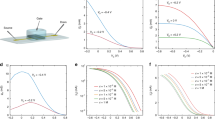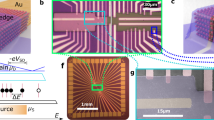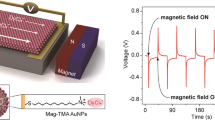Abstract
Transistors are typically based on inorganic or organic semiconductors. Metals have generally been considered unsuitable for such use because bulk metals screen electric fields and thus achieving electrically tunable conductivity is difficult. Alternatively, gradients of counterions in films of metal nanoparticles functionalized with charged organic ligands can be used to construct electronic devices, including resistors, diodes and sensors, but modulating the conductivity in these systems has also proven to be challenging. Here we show that transistors and logic circuits can be created from thin films of functionalized gold nanoparticles using dynamic ionic gradients established via an unconventional five-electrode configuration. The transistors are capable of a 400-fold modulation of electrical conductivity, and by combining with metal nanoparticle diodes and resistors, can be used to construct NOT, NAND and NOR logic gates, as well as a half-adder circuit. We also show that transistors deposited on flexible substrates continue to work when deformed and can withstand electrostatic discharges.
This is a preview of subscription content, access via your institution
Access options
Access Nature and 54 other Nature Portfolio journals
Get Nature+, our best-value online-access subscription
$29.99 / 30 days
cancel any time
Subscribe to this journal
Receive 12 digital issues and online access to articles
$119.00 per year
only $9.92 per issue
Buy this article
- Purchase on Springer Link
- Instant access to full article PDF
Prices may be subject to local taxes which are calculated during checkout






Similar content being viewed by others
Data availability
The data that support the plots in this paper and other findings of this study are available from Y.Y. upon reasonable request.
References
Shockley, W. The theory of p–n junctions in semiconductors and p–n junction transistors. Bell Syst. Tech. J. 28, 435–489 (1949).
Shockley, W. A unipolar ‘field-effect’ transistor. Proc. IRE 40, 1365–1376 (1952).
Sze, S. M. & Ng, K. K. Physics of Semiconductor Devices (John Wiley & Sons, 2007).
Hills, G. et al. Modern microprocessor built from complementary carbon nanotube transistors. Nature 572, 595–602 (2019).
Talapin, D. V. & Murray, C. B. PbSe nanocrystal solids for n- and p-channel thin film field-effect transistors. Science 310, 86–89 (2005).
Radisavljevic, B., Radenovic, A., Brivio, J., Giacometti, V. & Kis, A. Single-layer MoS2 transistors. Nat. Nanotechnol. 6, 147–150 (2011).
Lin, Z. et al. Solution-processable 2D semiconductors for high-performance large-area electronics. Nature 562, 254–258 (2018).
Geim, A. K. & Novoselov, K. S. The rise of graphene. Nat. Mater. 6, 183–191 (2007).
Qiu, C. G. et al. Scaling carbon nanotube complementary transistors to 5-nm gate lengths. Science 355, 271–276 (2017).
Dimitrakopoulos, C. D. & Malenfant, P. R. L. Organic thin film transistors for large area electronics. Adv. Mater. 14, 99–117 (2002).
Wang, S. H. et al. Skin electronics from scalable fabrication of an intrinsically stretchable transistor array. Nature 555, 83–88 (2018).
Rotkin, S. V. & Hess, K. Possibility of a metallic field-effect transistor. Appl. Phys. Lett. 84, 3139–3141 (2004).
Novoselov, K. S. et al. Electric field effect in atomically thin carbon films. Science 306, 666–669 (2004).
Liu, Q. et al. All-metallic high-performance field effect transistor based on telescoping carbon nanotubes: an ab initio study. J. Phys. Chem. C 115, 6933–6938 (2011).
Bitton, O., Gutman, D. B., Berkovits, R. & Frydman, A. Multiple periodicity in a nanoparticle-based single-electron transistor. Nat. Commun. 8, 402 (2017).
Makarenko, K. S. et al. Bottom-up single-electron transistors. Adv. Mater. 29, 1702920 (2017).
Kumar, A. & Dubey, D. Single electron transistor: applications and limitations. Adv. Electron. Electr. Eng. 3, 57–62 (2013).
Feldheim, D. L. & Keating, C. D. Self-assembly of single electron transistors and related devices. Chem. Soc. Rev. 27, 1–12 (1998).
Nakanishi, H. et al. Dynamic internal gradients control and direct electric currents within nanostructured materials. Nat. Nanotechnol. 6, 740–746 (2011).
Zhao, X. et al. Charged metal nanoparticles for chemoelectronic circuits. Adv. Mater. 31, 1804864 (2019).
Yan, Y., Warren, S. C., Fuller, P. & Grzybowski, B. A. Chemoelectronic circuits based on metal nanoparticles. Nat. Nanotechnol. 11, 603–608 (2016).
Cho, E. S. et al. Ultrasensitive detection of toxic cations through changes in the tunnelling current across films of striped nanoparticles. Nat. Mater. 11, 978–985 (2012).
Zhao, X. et al. Switchable counterion gradients around charged metallic nanoparticles enable reception of radio waves. Sci. Adv. 4, eaau3546 (2018).
Brust, M., Bethell, D., Schiffrin, D. J. & Kiely, C. J. Novel gold-dithiol nano-networks with nonmetallic electronic-properties. Adv. Mater. 7, 795–797 (1995).
Terrill, R. H. et al. Monolayers in three dimensions: NMR, SAXS, thermal, and electron hopping studies of alkanethiol stabilized gold clusters. J. Am. Chem. Soc. 117, 12537–12548 (1995).
Wuelfing, W. P., Green, S. J., Pietron, J. J., Cliffel, D. E. & Murray, R. W. Electronic conductivity of solid-state, mixed-valent, monolayer-protected Au clusters. J. Am. Chem. Soc. 122, 11465–11472 (2000).
Zouaoui, M. J., Nait-Ali, B., Glandut, N. & Smith, D. S. Effect of humidity on the dielectric constant and electrical impedance of mesoporous zirconia ceramics. J. Eur. Ceram. Soc. 36, 163–169 (2016).
Zabet-Khosousi, A. & Dhirani, A. A. Charge transport in nanoparticle assemblies. Chem. Rev. 108, 4072–4124 (2008).
Stojanović, M. N. & Stefanović, D. Deoxyribozyme-based half-adder. J. Am. Chem. Soc. 125, 6673–6676 (2003).
Senturia, S. D. & Wedlock, B. D. Electronic Circuits and Applications (John Wiley & Sons, 1975).
Acknowledgements
This work was supported by the Strategic Priority Research Program of Chinese Academy of Sciences (XDB36000000) and the National Natural Science Foundation of China (21571039). We thank B. Lu for helpful discussions and support on modelling. B.A.G. acknowledges the generous personal support from the Institute of Basic Science, Korea (award IBS-R020-D1).
Author information
Authors and Affiliations
Contributions
X.Z. carried out the experiments and performed the data analysis with J.G., T.X., Y. Zhou and Y. Zhang. L.Y. and B.T. modelled the experimental results. All the authors wrote the manuscript. B.A.G. and Y.Y. conceived and supervised the project.
Corresponding authors
Ethics declarations
Competing interests
The authors declare no competing interests.
Additional information
Publisher’s note Springer Nature remains neutral with regard to jurisdictional claims in published maps and institutional affiliations.
Supplementary information
Supplementary Information
Materials and methods, theoretical details and Supplementary Figs. 1–15.
Rights and permissions
About this article
Cite this article
Zhao, X., Yang, L., Guo, J. et al. Transistors and logic circuits based on metal nanoparticles and ionic gradients. Nat Electron 4, 109–115 (2021). https://doi.org/10.1038/s41928-020-00527-z
Received:
Accepted:
Published:
Issue Date:
DOI: https://doi.org/10.1038/s41928-020-00527-z
This article is cited by
-
All-optical generation of static electric field in a single metal-semiconductor nanoantenna
Light: Science & Applications (2023)
-
An artificial synapse based on molecular junctions
Nature Communications (2023)
-
Iontronic components: From liquid- to solid-states
Nano Research (2023)
-
Facile fabrication of a single-particle platform with high throughput via substrate surface potential regulated large-spacing nanoparticle assembly
Nano Research (2022)



